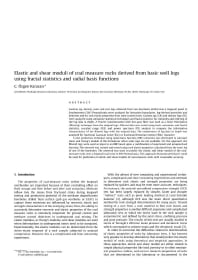Mining Publication: Elastic and Shear Moduli of Coal Measure Rocks Derived from Basic Well Logs Using Fractal Statistics and Radial Basis Functions
Original creation date: December 2009
Authors: C� Karacan
NIOSHTIC2 Number: 20036130
Int J Rock Mech Min Sci 2009 Dec; 46(8):1281-1295
Gamma ray, density, sonic and core logs obtained from two boreholes drilled over a longwall panel in Southwestern (SW) Pennsylvania were analyzed for formation boundaries, log-derived porosities and densities and for rock elastic properties from sonic transit times. Gamma ray (GR) and density logs (DL) were analyzed using univariate statistical techniques and fractal statistics for similarity and ordering of the log data in depth. A Fourier transformation with low-pass filter was used as a noise elimination (filtering) technique from the original logs. Filtered data was tested using basic univariate and fractal statistics, rescaled range (R/S) and power spectrum (PS) analysis to compare the information characteristics of the filtered logs with the original data. The randomness of log data in depth was analyzed for fractional Gaussian noise (fGn) or fractional Brownian motion (fBm) character. A new prediction technique using radial basis function (RBF) networks was developed to calculate shear and Young's moduli of the formations when sonic logs are not available. For this approach, the filtered logs were used as input to an RBF based upon a combination of supervised and unsupervised learning. The network was trained and tested using rock elastic properties calculated from the sonic log of one of the boreholes. The network was used to predict the elastic and shear moduli of the coal-measure rocks over a longwall coal mine in SW Pennsylvania. This approach demonstrated that it could be used for prediction of elastic and shear moduli of coal-measure rocks with reasonable accuracy.

NIOSHTIC2 Number: 20036130
Int J Rock Mech Min Sci 2009 Dec; 46(8):1281-1295
- Critical Review of Numerical Stress Analysis Tools for Deep Coal Longwall Panels Under Strong Strata
- Development of Guidelines for the Design of Support Systems to Manage Coal Mine Rib Hazards
- Development of Multiple Regression Functions for Performance Prediction of Gob Gas Ventholes for Sealed and Active Longwall Mines
- Electromagnetic Noise in Itmann Mine
- A Hybrid Statistical-Analytical Method for assessing Violent Failure in U.S. Coal Mines
- Numerical Modeling of Paste Sills in Underhand Cut & Fill Stopes
- Numerical Modeling Procedures for Practical Coal Mine Design
- Peak Methane Concentrations During Coal Mining: An Analysis
- Reservoir Rock Properties of Coal Measure Strata of the Lower Monongahela Group, Greene County (Southwestern Pennsylvania), from Methane Control and Production Perspectives
- Stochastic Modeling of Gob Gas Venthole Production Performances in Active and Completed Longwall Panels of Coal Mines